Introduction:
Avez-vous un vêtement préféré endommagé par un trou? Or Do you have an “;oops”; moment où tu abîmes tes vêtements?
Don’;Je ne perds pas espoir!
EMdigitizing a une solution pour vous!
Vous pouvez les réparer avec une machine à broder et les rendre encore plus attrayants. Réparer les trous avec une machine à broder est un excellent moyen de prolonger la durée de vie de votre vêtement préféré, et tu n'as pas besoin d'en acheter de nouveaux.
Dans ce guide complet, we’;Je vais explorer diverses techniques pour réparer, correctif, et embellissez vos vêtements grâce à la puissance de la broderie machine.
Nous avons également une offre intéressante pour les amateurs de broderie, alors reste sur la page jusqu'à la fin.
À présent, creusons!
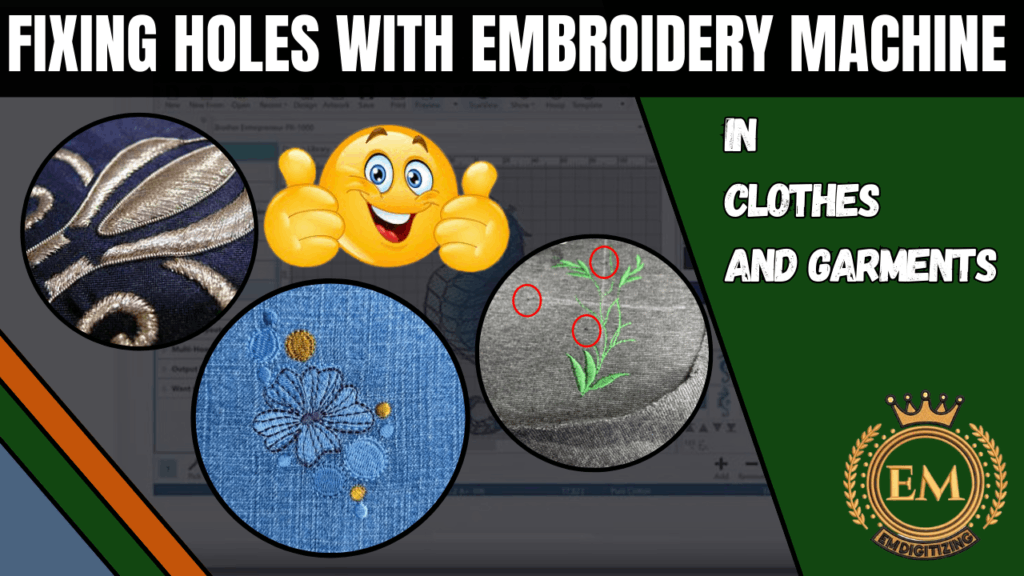
Trous de fixation avec machine à broder dans les vêtements et vêtements
Techniques de fixation des trous avec une machine à broder
Avant de passer aux façons de réparer les trous avec la broderie machine, vous devez vous concentrer sur ces techniques avant de procéder à tout processus de réparation des trous.
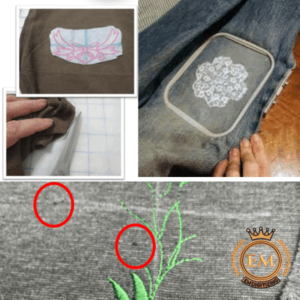
1. Cerclage approprié
La meilleure façon de réparer les trous dans les tissus à broder est de les entourer correctement.. Enroulez fermement le tissu déchiré avant de continuer., et assurez-vous que le trou est au centre. Cela aidera la machine à broder à coudre le motif avec précision..
2. Stabiliser le tissu
Si vous voulez éviter que le trou ne s'agrandisse à mesure que vous brodez, you’;il faudra stabiliser le tissu. Vous pouvez réparer la zone autour du trou avec un stabilisateur détachable.. La machine à broder pourra travailler régulièrement sur ce point.
3. Choisir le bon design
It’;Il est important de choisir le bon motif lorsque vous utilisez un Machine à broder pour réparer des trous. Le motif doit être suffisamment grand pour couvrir le trou et suffisamment épais pour maintenir le tissu ensemble.. Aussi, un motif dense aidera à empêcher le trou de s'agrandir.
4. Tester la conception
It’;s important to test the pattern to make sure it’;c'est la bonne taille et le bon poids pour le tissu. It’;C'est une bonne idée de s'entraîner à coudre le motif sur un morceau de tissu avant de broder sur le vêtement lui-même.. Cela permettra d'éviter plus facilement toute erreur et de garantir que le motif s'adaptera parfaitement au trou..
Comment utiliser la broderie machine pour réparer les trous?
Voyons comment vous pouvez réparer les trous courants dans vos vêtements et vêtements..
Réparer les déchirures en forme de L avec de la broderie
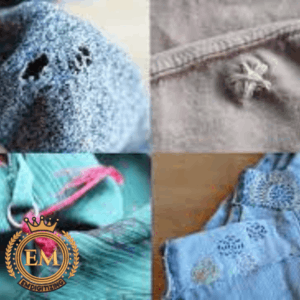
The “;L”;-la déchirure des vêtements est un problème régulier pour beaucoup d'entre nous. Vous avez peut-être accidentellement déchiré votre jean sur un ongle, leaving a rip that doesn’;ça a l'air bien. It’;c'est normal de se sentir mal à propos de ce qui s'est passé, mais la broderie machine peut vous aider à créer quelque chose de beau.
Voici les étapes pour réparer les déchirures en forme de L:
- Retournez le vêtement endommagé et posez-le à plat..
- Appliquez une petite quantité de stabilisateur thermocollant doux à l'aide d'un fer à repasser pour maintenir le tissu déchiré..
- Hoop the garment with a stabilizer once you’;je l'ai retourné.
- Choisissez un motif de broderie que vous aimez vraiment, but make sure it’;est au moins un quart de pouce plus grand que la déchirure afin que vous ayez de l'espace pour travailler.
- Once you’;j'en ai fini avec la broderie, il suffit de retirer le support. Vos jeans ont maintenant ce look de créateur haut de gamme.
Vous pouvez nous contacter pour numérisation de broderie des motifs qui donnent à vos vêtements endommagés un look design. Nous numérisons manuellement votre dessin et veillons à ce qu'il recouvre correctement le trou..
Réparer les déchirures des coutures
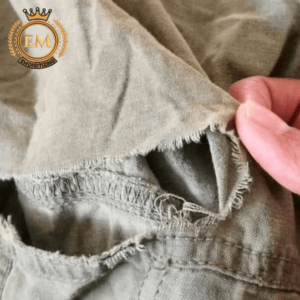
Les déchirures dans les coutures sont un peu plus difficiles à réparer, car broder sur la couture pliée peut causer des dommages permanents à votre machine à broder..
Here’;C'est un moyen de réparer les coutures déchirées et d'éviter d'autres dommages à votre machine.
- Utilisez un stabilisateur pour renforcer la couture.
- Ajoutez un autre morceau de tissu et resserrez la couture en cousant d'avant en arrière avec un point zigzag à l'aide d'une machine à coudre standard..
- À présent, recouvrir la broderie en zigzag d'un patch brodé.
Utilisez la broderie pour renforcer le tissu usé
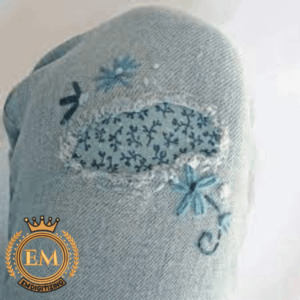
It’;il est facile de récupérer le tissu endommagé. Here’;c'est ce que tu dois faire:
- Entoilage thermocollant pour maintenir le tissu en place.
- Appliquer un stabilisateur sur le tissu, entoure-le, et broder le motif.
- Pour le rendre plus fort, choisissez des motifs grands et pas trop denses.
Broder sur des trous dans des tissus tissés

It’;s important to be careful while working with knit fabric so their softness isn’;t affecté. Suivre ces étapes vous aidera à broder habilement sur les trous des tissus tricotés.:
- Cercer correctement est vraiment important. Enroulez votre entoilage et tricotez avec le trou au milieu du cerceau pour empêcher ces vêtements de flotter.
- Si vous souhaitez boucher le trou avec votre propre design, we suggest using a knockdown stitch called a “;Hatch Smash.”; Ce point est recommandé pour les matières à poils denses car il évite que les aiguilles ne se coincent.
Autres techniques pour réparer les trous avec une machine à broder
Les moyens mentionnés ci-dessus pour réparer les trous courants. Mais pour les gros trous, vous pouvez essayer toutes les techniques mentionnées ci-dessous:
Broderie découpée pour fixer de grands trous
Y a-t-il un gros trou dans votre vêtement? Il manque peut-être du tissu. Vous pouvez utiliser cette faiblesse à votre avantage en effectuant des découpes.!
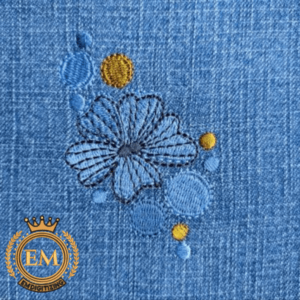
Êtes-vous prêt à réparer de gros trous avec de la broderie découpée? You won’;Je ne crois pas à quel point c'est facile!
Vous pouvez redonner à vos vêtements endommagés un aspect neuf en quelques étapes simples..
- Sélectionnez un motif à utiliser comme patch et découpez-le dans le tissu. Si vous n'avez pas le bon design, puis contactez EMnumérisation. Nous préparons pour vous des designs à des prix abordables que vous n'auriez jamais imaginés, et votre machine peut facilement comprendre la conception.
- Pour combler l'écart, utilisez des points de boutonnière autour.
- Coupez le tissu à l'intérieur de la couture de la boutonnière.
- Pour masquer les bords bruts du trou, utiliser un point satin.
- Fixez la broderie découpée au tissu à l'aide d'un point courant.
Conseil de pro: Si le trou est très grand, Vous voudrez peut-être soutenir le tissu avec un morceau de stabilisateur pour l'empêcher de plier.
Numérissez votre conception vous-même
Pour réparer les trous avec une machine à broder, vous pouvez numériser la conception en fonction du trou par vous-même. Cela peut être une expérience amusante et enrichissante. Il existe de nombreux logiciels de numérisation de broderie disponibles, comme le logiciel Hatch. Si vous souhaitez en savoir plus sur le logiciel de numérisation de la broderie Hatch, Cliquez ici.

Mais pour les débutants, Numériser la conception par vous-même peut être difficile. quelquefois, Même les brodeurs expérimentés sont confrontés à des difficultés à faire des conceptions. Alors ne t'inquiète pas! Emdigitising a expérimenté le personnel qui numérise manuellement votre conception avec un revirement rapide. Vous n'avez donc pas besoin d'attendre longtemps pour faire votre conception.
Broder sur un tissu en ruine avec une machine
If there isn’;T même une façon de réparer les trous dans vos vêtements, they won’;t à être utile. Mais nous voulons toujours que tu le gardes.
La broderie de machine permet de réutiliser des tissus anciens ou même en ruine pour d'autres projets de broderie afin que vous puissiez les recycler.
Être créatif et broder quelque chose de très spécial en utilisant des pièces de tissu, correctifs, ou applique.
Nous mentionnons également des moyens créatifs de réparer les trous dans les vêtements et les vêtements.
Utilisez des poches pour réparer le trou
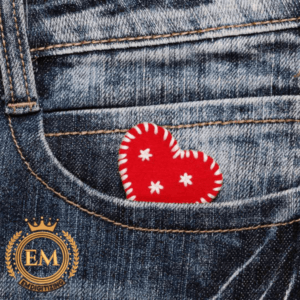
Si vous avez besoin de réparer de gros trous dans vos vêtements, Vous pouvez faire des poches dessus et faire ressembler des vêtements à nouveau. Voici comment procéder:
- Créer un patch qui est 3/4 pouce (2 cm) assez grand pour couvrir le trou. Vous pouvez remplacer la doublure de poche par n'importe quel matériau d'un poids similaire.
- Maintenant, brodez tout design que vous aimez sur ce tissu avec une machine à broder.
- Prochain, you’;il faut épingler le patch sur la zone endommagée.
- Appliquez le patch sur la doublure de poche avec un point de course ou un point d'échelle.
- Coupez tout excès de tissu du patch.
Vous pouvez nous considérer pour des conceptions de numérisation de broderie sur les poches. Nos créations s'intègrent parfaitement dans les poches et donnent à vos vêtements un nouveau look.
Emballer: La broderie de machine transforme les accidents en créativité
La broderie de machines est un outil créatif et flexible qui peut vous aider à réparer les trous, des larmes, spots, et autres défauts dans les vêtements. Ne jetez pas vos vêtements; au lieu, Essayez de les réparer ou de les changer de manière unique.
Vous avez diverses options, allant des restaurations traditionnelles aux éléments de conception innovants. La broderie de machine vous permet d'exprimer votre créativité, Essayez de nouvelles choses, et améliorez votre garde-robe.
Offre passionnante pour les fans de broderie
Si vous recherchez le meilleur numérisation de broderie et services d'art vectoriel, Puis l'emdigitation est votre lieu de choix. Nous proposons actuellement 50% de réduction sur votre première commande, et vous pouvez également obtenir un DEVIS GRATUIT en seulement 5 minutes de nos experts.
Alors, êtes-vous prêt à faire passer votre projet de broderie au niveau supérieur?
N'hésitez pas à nous contacter afin que nous puissions discuter de vos besoins et travailler ensemble pour transformer vos idées en belles œuvres d'art..
Pour terminer, si vous trouvez ce guide utile, partagez-le avec vos partenaires de broderie.
Merci d'avoir lu!
Vous pouvez utiliser une backstitch ou un point de course pour réparer une larme. Vous pouvez coudre des trous de n'importe quelle taille avec ces deux points, qui sont forts et durent longtemps.
Oui, vous pouvez broder sur des trous. C'est une façon amusante de réparer l'ancien tissu et de le rendre meilleur en même temps. Choisissez votre conception de broderie Couleur de point et de fil judicieusement pour effectuer une réparation qui durera et auront l'air bien.
Il existe de nombreuses façons de réparer les trous dans le tissu, Mais deux méthodes simples et efficaces sont:
- Couture: Sew the hole’;S bords ensemble à l'aide d'une aiguille et d'un fil. C'est la méthode la plus durable, Mais cela peut prendre du temps pour les gros trous.
- Radiation: Cousez une parcelle de tissu sur le trou. Ceci est une méthode rapide et facile, Mais ce n'est peut-être pas aussi durable que la couture.
